Occasionally I have those FTP jobs to either download or upload a truck load of files – for example when I want to make a backup of my website.
Now you could start a regular FTP client on your PC and have it run all night to do just that, or … you could use your QNAP for that – mine is running 24/7 anyway, so why not? The biggest issue is: where do you find a FTP client that can download or upload entire directory structures?
Download Station, and the likes, only take one URL at a time, or other apps do silly things like zipping all files before up- or download (who came up with THAT idea?).
After a long search I found something interesting; One of the best hidden features of File Station, the file manager in the web-interface of your QNAP, is the fact that it supports FTP … albeit poorly documented and hard to find … in this article: how do we do this with QTS 4 (tested with QTS 4.2.1). Note that this only supports regular FTP, so not SFTP!).
QNAP FTP Client: File Station
NOTE: Newer QTS versions use HybridMount instead …
Newer versions of QTS come with a version of File Station that no longer provides this button / option.
Instead QNAP released an application called “HybridMount” to manage network shares, and supports FTP, SMB etc.
Thanks to Vladimir for making me aware of this 
File Station is the file management tool that standard comes with you QNAP and can be accessed through the standard web interface. It can be found on the main page of the QNAP web interface, look for this icon:

QNAP File Station Icon
It surprised me to find even this option: why would anyone hide such a feature this well?
Try finding that in the online manuals, support pages or FAQ’s …
File Station, even when you’re not connected to your QNAP, will continue doing it’s work (you can see it in the “task running” queue).
However you’ll have to do some tests to see how well the server you’re connected to, stays connected.
Ad Blocking Detected Please consider disabling your ad blocker for our website.
We rely on these ads to be able to run our website.
You can of course support us in other ways (see Support Us on the left).
Download or Upload through FTP with File Station
To use File Station as an FTP client, not to be confused with an FTP server (!), is quite simple,… once you know how to do it.
We will first need to define a connection, so let’s get started by opening File Station.
Setup Remote Connection
In the toolbar you’ll see a little computer monitor like icon with a checkmark in it (see illustration below).
Click this icon and choose “Create remote connection“.

QNAP File Station – Create Remote Connection
A window called “Create remote connection” will open, where we have to click the FTP Icon followed by a click on the “Next” button.
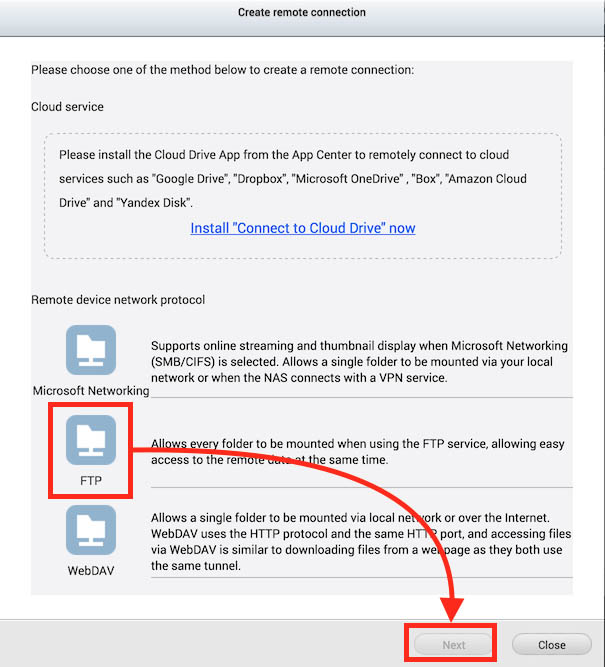
QNAP File Station – Select FTP Connection
Another window will now open, asking you for the server specific parameters:
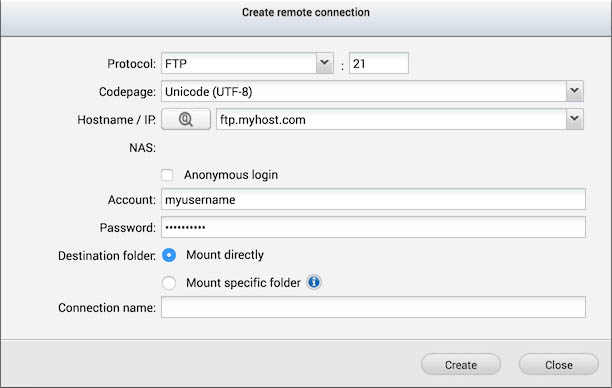
QNAP File Station – FTP Settings
Here you enter the desired protocol (FTP), Port number (default: 21), Hostname or server IP address, your login credentials (username, password) and the name you’d like to use for this connection. If you leave the connection name blank, the server name will be used.
When done, click “Create“.
Working with the Remote Connection
When this all worked out well, your FTP connection will be mounted and seen as a “drive”;
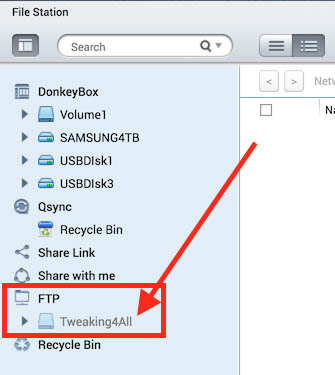
QNAP File Station – FTP server as a drive
After creating a remote connection, the drive will be mounted right away. The “drive” for your FTP server will remain in this list, but in the future you might need to reconnect to the server. As seen above, “Tweaking4All” is greyed out, so we need to reconnect, which is done by right clicking the “drive” and choosing the option “Connect“.
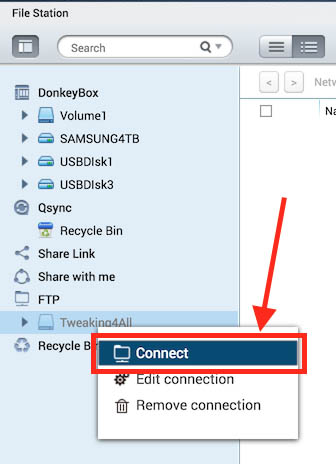
QNAP File Station – Reconnect to FTP server
Once the connection exists, folders and files can be accessed, just as you would with regular drives on your QNAP. So you can copy, move, rename, delete etc. Just like with regular QNAP drives, copying or moving entire directory trees goes very easy.
One thing to notice is that when you look at the background tasks, that the information might not quite reflect the amount of files or data that needs to be copied or moved. Rest assured, everything will be copied/moved as requested.
When done working with your remote FTP connection, you can right click the “drive” again and disconnect – just make sure all tasks have completed.
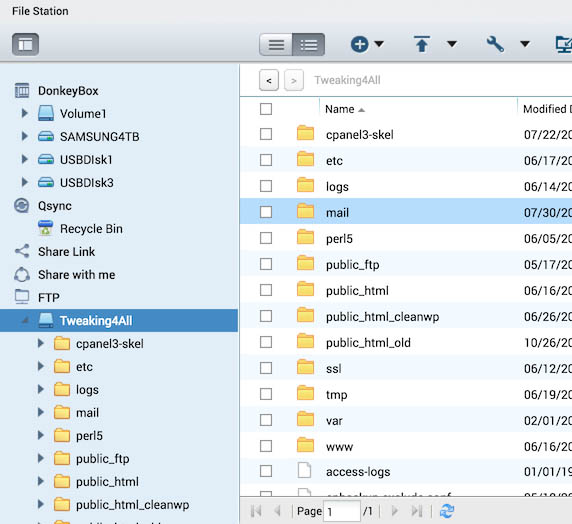
QNAP File Station – FTP access as if it is a drive

QNAP File Station – Background Tasks

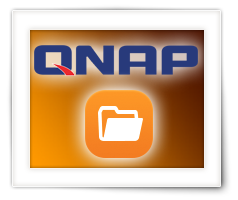








Comments
There are 17 comments. You can read them below.
You can post your own comments by using the form below, or reply to existing comments by using the "Reply" button.
This is great, just what i have been looking for!! thankyou :)
GGG
Thanks GGG!
I’m glad to hear this was useful to you, and thank you for taking the effort to post a thank you note – it’s much appreciated!
hans
You gave me the solution I’ve been just looking for! Didn’t know about your site though… Maybe google is our friend at last
Thank you so much!
Kostas
Hi Kostas,
I’m glad to hear you found us through Google and that the solution works for you! Awesome!
Thanks for posting a thank-you – it’s very much appreciated!
hans
How to access to file station over internet for your configuration without using FTP Client and MyQNAP cloud?
loy
Hi Loy,
Even though I would not necessarily recommend this, you could map the needed ports in your modem/router so outside traffic is redirected to your QNAP. Be careful when doing this though, as you should be concerned with security issues. So for one I’d use a very strong password, and I’d enable SSL (which comes with it’s own challenges).
If however you have a good modem that supports VPN, then you could enable that and use VPN to connect to your home network. Everything then should work as if you’re sitting next to your QNAP (that’s how I do it). The use of VPN comes with it’s challenges though, and with VPN I do not mean those 3rd party services. I mean running VPN on your modem and most modems are not able to do this.
hans
Hello and thanks for the procedure! It’s very convenient. One thing, though – when I’m downloading from my company’s FTP server (RAW video files), but the fastest I can get any individual file to download is 3.33Mb/sec. I have a 1G ISP connection and if I download using my PC I can get much faster download speeds (avg. 30mb). On the positive side, I can download say, ten (10) files individually, at 3.33Mb/s each, but don’t need that capability very often. Is there something I’m missing/not doing to get faster downloads? Thanks.
itdpinc
Hi Itdpinc,
Yeah, it’s not the best FTP client ever. I’d start with testing FTP from an SSH shell. Connect to SSH on your QNAP and try the command-line version of “ftp” (ie. ftp yourserver.com) and see if you get comparable speeds. My guess is that the FileStation has it’s limitations. If the command-line version is faster, then I think it’s time to contact QNAP support (they do a pretty good job actually) and either ask for assistance or file a bug report or feature request. Granted, feature requests can take a while … but with regular support they have been quite helpful.
In case you bump into a “fix” then please let us know!
hans
I used this a week ago to move files from a Thecus Nas. The icon you reference isn’t showing in File Station 5. I thought I used the tools drop-down to make the remote connection but can’t find that option now. Any ideas where it’s hiding or if it was removed?
Merlin
Hi Merlin,
This article is a bit dated.
I do not have access to my QNAP right now, but as far as I could find in the documentation, you should use the 5th button from the left in the second screenshot (#10 under “Familiarizing yourself with File Station”).
Hope this helps
Hans
It helped sort of anyway. The help instructions aren’t up to date.
The icon is no longer next to the tools icon, it’s now a large orange circle in the top RH corner as shown in the attachment.
Before using it you must install HybridMount free from their app store. after doing that, the instructions say to answer all of the required blocks, but they aren’t that self-explanatory. For some reason, the format of the connection name is critical, not the server name, but the name you give to the connection you wish to manage. I found that out after a series of attempts to change things that weren’t the issue. The error log isn’t helpful.
I connected with my admin login to the NAS I wanted to transfer files from and could navigate the file tree and open files. However, when I tried to FTP the files it failed, Task manager said I didn’t have the privileges required to move or copy (I tried both) the files. I fired up a laptop and had no problem copying a few files over. I wanted to use FTP because there are some large ISO files stored that I need to move off the old Thecus Nas before I retire it.
I don’t know what I’m missing, because all the permissions look right and before the last update I used your method with those permissions to transfer similar files from the same system. It’s probably a Hydridmount issue.
I have a screenshot but it appears I can’t attach it here.
Merlin
Hi Merlin,
good to hear you made some progress, sad to hear FTP is being a pain.
Unfortunately, I’m on vacation right now, so I do not have access to my gear.
Yep, the Help isn’t the best, but in my experience Help functions on most systems or applications are not very useful to begin with.
As for the FTP issues, I’d check a few things on the FTP server. Maybe the credentials for the connection aren’t allowing your to do certain things, or it didn’t use the credentials when connection (more likely, since it worked OK on your laptop).
Posting pictures is something you cannot do in the the comments – unfortunately in the past people used it to post inappropriate pictures or an excessive amount or size pictures. You can however post pictures in the Forum (QNAP topic).
Hans
Hans, your article is just great! I busted my head looking fot FTP connection on Qnap NAS, and no luck until I read this.
Could you please help a bit more? I have Qnap TS-103, and FileStation is there, but NO ICON for creating remote connection (neither I could find it via Help or on Qnap site).
Is it possible that this device does not support the FTP client feature, or maybe my (the latest) software version is different than your tutorial shows?
I would be eternally grateful if you help me with this!
Thanks in advance,
V
Vladimir Eric
Hi Vladimir,
apologies for not updating the article in a while – I haven’t been using this feature in quite a while.
I did some searching for you and found that QNAP moved this to a tool called “HybridMount” (look for “HybridMount” in App Center – it is a tool from QNAP themselves).
This allows you to mount an FTP share as a network drive (and it has a lot of other features like mounting SMB shares etc).
See also this guide at QNAP. Maybe I’ll write an article in the future about this
p.s. Thanks for the coffee and thanks for teaching me something new as well (I had not seen this application yet haha).
Hans
Feel free to ask for help if you need any …
Hans
Dear Hans,
I can’t thank you enough for such a prompt and detailed, very useful reply. I found everything that I needed, managed to create FTP connections, and it all works flawlessly.
The last step is finishing-up remote access to NAS (from any other network). I got stuck halfway, but I believe I will complete it successfully.
Thanks again for the help!
Vladimir Eric
You’re most welcome
Good to hear this worked out!
As for remote access: you have a few options.
1. Easiest: Through QNAP’s MyQNAPCloud – it’s free and uses SSL for it’s connection.
I’m not thrilled about this one since my data goes “through” their servers (from what I understood after reading a warning that users shouldn’t go crazy on the amount of data they are sending back and forth). Additionally, I would not like to have such a connection open to towards the Internet.
2. You could consider using the VPN service on your QNAP.
You’ have to forward the VPN port(s) in your router to the QNAP, and your QNAP will handle the VPN.
Considering the QNAP you’re using (slow CPU), the speed over VPN will not be all that great.
3. Setup a VPN server on your router.
Modern Internet routers can have a build in option to run a VPN server on the router.
I’ve done this in the past and it works, however the speed may not be all that great. I managed to get just enough speed to stream my own video’s.
For some you may need to get special firmware, like ddWRT, Tomato, xWRT or something like that.
4. Setup a dedicated firewall, running a VPN server.
As an alternative, you can setup your own firewall (using pfSense or OPNSense – I’ve used both and they both are excellent) and having that run your VPN server, which allows for better/faster hardware (for example an old PC, or a small PC (I’m using a small passive cooled dual core i7, like this one).
This is what I’m using at the moment and the speed of the VPN connection is very good.
I guess it all depends on what you need, how much you’d like to spend, and how much you trust QNAP or other 3rd parties
Hans